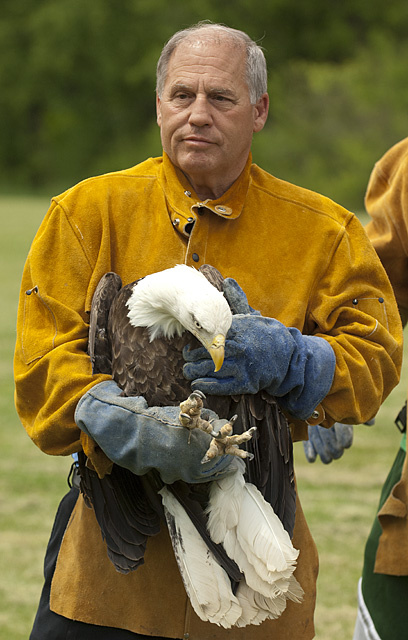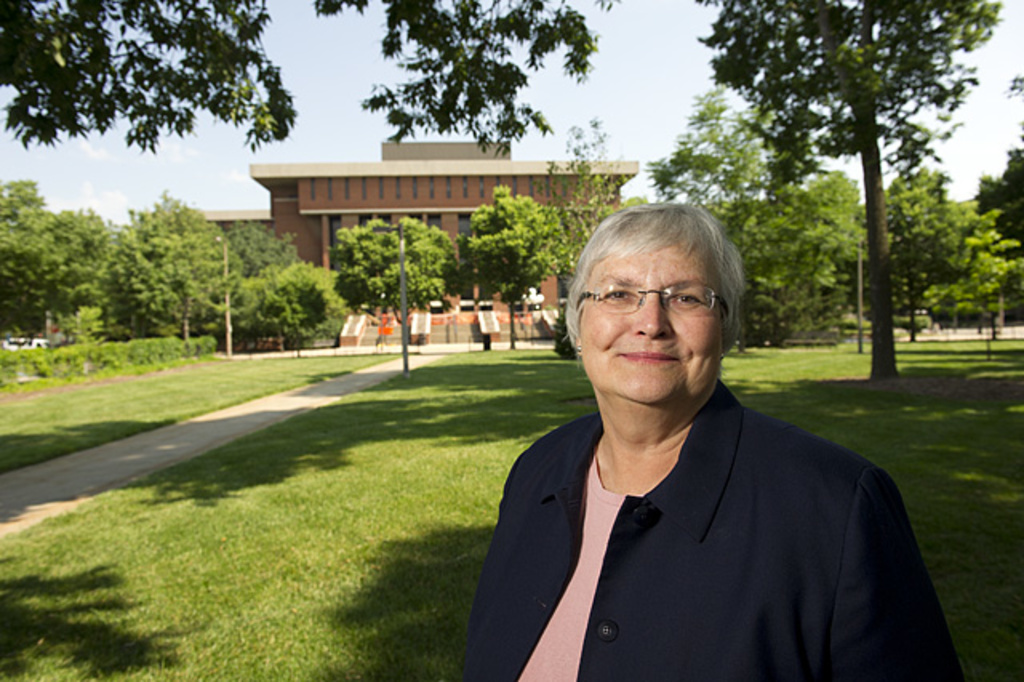Whether your summer vacation lasts a week or two or 10, for most of us, the return to work is inevitable. Unless you happen to be among the more than 230 University of Iowa employees who began a sort of permanent vacation in the last year. That is, retirement.
Iowa Now caught up with a few of our departing colleagues to hear a bit about their work, share the excitement of their future plans, and perhaps capture just a bit of that “institutional memory” they are taking with them.

Harry Ostrander: Promoting campus health through recreation
Harry Ostrander has spent more than 40 years helping University of Iowa students, faculty, and staff stay healthy.
“At first, I intended to work until age 62. Then I hit 65. Then I hit 70 last year,” says the longtime director of UI Recreational Services. He segues into phased retirement this summer, but Ostrander isn’t done yet.
In 1969, he was working at Florida State University when he got a call from UI athletic director Forrest Evashevski, who invited Ostrander to run the university’s recreation programs.
“He told me, ‘We want you here in two weeks,’” Ostrander recalls. “I came back not knowing for sure what I’d be doing.”
Then housed in the men’s athletic department, the rec program had a staff of seven students and a $22,000 budget. Today part of the Division of Student Life, the program has about 46 full-time and 500 part-time staff, and a budget of $14.3 million.
Student expectations, cultural changes, and awareness that recreation programs support better overall student outcomes have driven that growth. The UI today offers more indoor recreation space per student than any other Big Ten school.
Ostrander has been instrumental in developing virtually every recreation facility on campus, all the way up to his crowning achievement—the 2010 opening of the Campus Recreation and Wellness Center (CRWC).
He’ll spend the next couple of years planning the building’s second phase, to be located due south of the current CRWC.
Originally from Ohio, Ostrander finished high school in Iowa City and went on to play baseball at the UI, where he earned bachelor’s and master’s degrees.
His background as a Hawkeye athlete helped him maintain strong partnerships with the UI athletic department. At Iowa, athletic and recreation programs share many facilities, a rather uncommon arrangement. “We don’t need to build separate facilities that sit vacant most of the day,” Ostrander says.
This kind of collaboration and smart planning have helped the university keep pace with student expectations.
“We’ve seen different areas take off, starting with expansion of intramurals for both men and women,” he says. “Then fitness started to grow, and programs became more individualized. Now we see more group exercise—Pilates, yoga, Zumba.”
Ostrander’s department has expanded outdoor recreation, too, introducing mountain biking, rock climbing, and cross country ski trips and establishing the Macbride Nature Recreation Area.
To Ostrander’s surprise, the Macbride Raptor Project has become one of his signature programs.
“One of my graduate assistants suggested a raptor program,” he recalls. “I said, ‘What’s a raptor?’”
The resulting center, a collaboration between the UI and Kirkwood Community College, has become a draw for areas schools. In fact, most of the programs Ostrander oversees are open to people of all ages, whether or not they’re connected to the university.
“We want to run programs that are aimed foremost at campus, but also benefit the community,” he says.
Promoting campus wellness remains a big focus. An incentive program slashes faculty and staff fees in half provided users log at least four visits to recreation facilities each month.
“We expected 10-15 percent of employees to take part,” Ostrander says. “Today we’re at 30 percent.” Working with UI Wellness, he and colleagues are assessing impact on absenteeism and other healthy workforce measures.
They’re also surveying impact on students. “We know who uses the facilities and can track GPA and retention rates,” Ostrander says. “Students often connect with each other through recreation programs, and that makes them more likely to stay and succeed.”
Looking back, Ostrander is glad he answered Evashevski’s call.
“I’m very lucky to have a job that’s the perfect fit for my personality, that lets me work for a university I love, with a lot of great people,” he says.

Jane Omann: Came for a year, stayed for 47
Jane Omann took a job as a file clerk in the Office of the Registrar in 1966 intending to stay for one year before putting her UI Spanish degree to work in the Peace Corps. Forty-seven years later, she retired this month as Senior Associate Registrar.
As for what happened in between, well, it’s just life, work, friends, history, progress, changes large and small. In short, an accidental, but rewarding career.
Omann moved to Iowa City from Dallas Center as a second grader when her oldest brother entered the university as a freshman. “My mother was a University of Iowa graduate (early 1920s) and it was just a given that her four children would attend.”
Growing up surrounded by all things Hawkeye—student siblings, professor neighbors, homecoming parades, Pentacrest Museums—Omann developed an admiration and respect for the university that would serve her well in her career.
“The university’s goal is to create new knowledge and disseminate it, and I’ve enjoyed being a little cog in that big machine,” she says.
With 47 years of practice, it’s no surprise she can sum up the work of the Registrar’s office in one crisp sentence: “We get students enrolled in courses so we can assess tuition and produce a transcript at the end of the semester.”
Early on, when student records were kept on paper, Omann’s job was to keep everything together in seemingly endless rows of file drawers. With the advent of technology—in particular the university’s new MAUI student records system—the three file drawers in her office are mostly empty. And since her colleagues all have access to the electronic data, she didn’t even have to spend her final weeks of work explaining her job to her successor.
As for retirement plans, she’s looking forward to “not getting up at the crack of dawn” and expanding her role as a volunteer at the Coralville Center for Performing Arts. She’ll be able to take in the week night shows now that she doesn’t have to be at work at 8 a.m., and when she’s not at the theater, she might just enjoy a bit of The Daily Show with Jon Stewart and The Colbert Report in real time instead of relying on her DVR.
And who knows, she might even be looking to cause a little trouble. After all, it was Omann and a few colleagues who had the temerity in the early 1970s to approach their supervisor seeking “permission to wear really nice pants suits instead of skirts with hose and heels.
“We were really bold people,” she says with a sly grin.

Nancy Baker: “I felt like I’d come home”
When University Librarian Nancy Baker came to the UI 13 years ago, she didn’t feel settled until her own books lined her office shelves. With a week to go before retirement, those books had found their way to boxes, new owners, and in a few cases, the pulper as she prepared to step away from her 40-year career.
“Some of those books I’ve had since my time in library school—not much use for them now,” she says.
It’s a good metaphor for the sweeping changes she’s seen in the profession. “When I walked into my first library job in upstate New York in the early 70s, the place looked almost like it had 50 years before,” she says. Stacks of books, card catalogues, bound journals, a few staff computer terminals connected to a huge mainframe, and typewriters for the public.
“The last 20 years have been remarkable—wonderful, really. But it’s an entirely different field—more exciting,” she says.
Today’s university librarians spend much more time teaching as the importance of being able to locate and use reliable information has become so central for students and researchers alike.
Baker is pleased to note that during her tenure, a good deal of that information—thousands of books and journals and more than a million items from more than 100 different Special Collections—has become more accessible to students and scholars as the library has made digitization a priority. Projects like DIY History have also helped expand the libraries’ collections, as people became aware of the material available here and donated related items.
All credit goes to resourceful and dedicated library staff, Baker says, who found ways to innovate and progress even in the absence of significant new funding.
“We’re lucky we’ve always had great support from the university administration,” Baker says, “but given the financial realities of the last decade, we’ve had to find ways to reallocate staff and resources internally. In difficult times it’s easy to retrench, but our staff has never been satisfied just to tread water.”
A fitting description, given the most memorable day of Baker’s tenure: June 14, 2008.
That was the day she was notified that the Main Library would be evacuated and closed due to the rising Iowa River. With only hours to work, the staff banded together with hundreds of volunteers to move as many items as possible from basement storage to higher levels.
Knowing they’d never get it all out in time, there was a triage mentality, Baker recalls, with dissertations receiving highest priority given that they were irreplaceable.
That summer is etched in the memories of all who lived through it, but for Baker, the events surrounding the library evacuation are a microcosm of the warm, homey feeling she’s had in Iowa despite being, technically, an outsider.
“There was just something about the spirit of people working together to save what they could and others showing up with meals and water and contributing in any way they could,” Baker says. “I’ve lived a lot of other places and loved them, but always felt kind of like a visitor. It wasn’t until I arrived in Iowa that I really felt like I’d come home.”
She hopes to cultivate that same sense of community in Santa Fe, N.M., where she and her husband will relocate in retirement. She is eager to become involved in volunteering in a way that wasn’t possible with the demands of her job, and may finally tackle learning to knit.
“I’ve been working since I was 16, so it’s going to be strange,” she says. “I have lots of ideas, but no plans.”